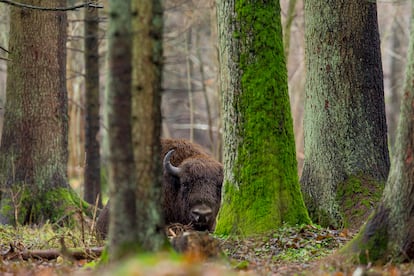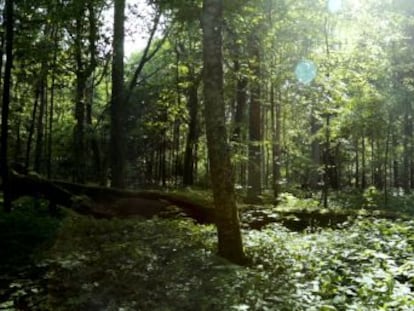Bison fur detects global change in Europe’s last virgin forest
A study of hair samples from 50 animal species in Bialowieza, Poland, collected over the course of seven decades, reveals the invisible effects of fossil fuel emissions

Over a decade ago, a group of scientists started looking for hairs of animals living in Poland’s Bialowieza lowland forest, Europe’s last remaining virgin forest. The team was tracking whether the modifications associated with global climate change had reached this type of natural, still primordial ecosystem and found that they had: in the forest, they analyzed the carbon and nitrogen isotopes from the hair of 50 mammal species in samples collected between 1946 and 2011. To locate these valuable samples of bison, lynx, wolves, shrews, voles, bats (the only flying mammals) and other animals, the scientists searched museum and private collections, and even went to private homes.
Patiently and meticulously, the researchers have shown that animals living in well-preserved places can “act like canaries in a mine, providing warning signs about environmental changes and becoming sentinels that help detect the invisible impacts of global change in a more holistic way,” they say. The results of this research were published in Global Change Biology. The scientists also believe that these parameters should be controlled and monitored on a regular basis.
“There are areas of the forest that have never been touched and we have obtained samples that are impossible to find anywhere else in Europe,” says Nuria Selva, a researcher at the Polish Academy of Sciences and the paper’s lead author; the research team also included researchers from Spain’s National Research Council, the University of Seville (Spain), the University of Huelva (Spain) and the University of Ontario (Canada). “If it were not for analysis of the hairs,” she points out, the researchers never would have realized what was happening. For example, the study found that the carbon isotope ratio in the fur of a bison from a collection 70 years ago, is different from that of a bison alive today. That is because of the increase of carbon dioxide (CO₂) — the main greenhouse gas — in the atmosphere, which is incorporated into the vegetation of the Bialowieza forest; from there, it is passed to animals when they feed. “Even if fossil fuel emissions are emitted in China, they reach here,” Selva observes.
One of the study’s most notable findings was the clear decrease in the proportion of nitrogen isotopes in the hairs of animals that were tested. That result coincides with an observed reduction in nitrogen concentration in tree leaves in the Bialowieza forest, explains Keith Hobson, another author of the study and an expert in stable isotope ecology. At the same time, the finding is in line with other research that has reached similar conclusions for natural forests. For example, a study of grasshoppers in North American prairies confirmed that nitrogen availability is decreasing in plants. “That can have a long-term effect, especially on herbivores, because it lowers the reproductive rate of the species, which eat the same amount of leaves that have poorer nutritional quality,” he adds.
Selva fears that there will be significant changes in the trophic networks, which are a set of food chains in an ecosystem interconnected with each other through feeding relationships. “If the basic nitrogen cycles change, it affects the foundations of that network, and it would be a cascading effect, the consequences of which we don’t know,” she says.
The Institute of Mammal Research of the Polish Academy of Science played a key role in locating the hairs for the study. After the end of World War II, the institution began systematically sampling animals and carrying out dietary studies through excrement. “We found matchboxes from the 1940s and 1950s with samples of a shrew species new to the forest,” Selva explains. The scientific team took hairs from the stuffed mammals, but they had trouble finding lynx and wolf hairs. The Institute of Mammal research “would tell us, ‘this hunter has a stuffed lynx in his house,’ and that’s where we’d go. Then we were missing shrews and had to find them,” says Selva, who knows the terrain and the hunters and locals well, having lived there for 22 years. They also had problems locating samples of bats; a local researcher helped them in that case as well.
The Bialowieza forest covers 150,000 hectares in Poland and Belarus; 10,000 hectares form the national park, and 6,000 hectares form the primeval forest, where there is minimal human intervention. The forest’s importance was recognized decades ago when it was declared a Biosphere Reserve in 1977 and a UNESCO World Heritage Site in 1979. Despite these protections, however, the area has faced different aggressions. The most recent one occurred with the construction of a huge wall that is 5.5 meters (18 feet) high and 186 kilometers (115.6 miles) long, which seeks to prevent the influx of migrants from Belarus. The wall has not just been criticized by human rights organizations, but environmental groups and scientists have also opposed it, warning that it represents an attack on the unique area’s fauna. The barrier crosses the reserve zone and blocks the migratory routes of bison, wolves and deer; the border between the two countries is one of the corridors that wildlife uses to cross between Eastern Europe and Eurasia.
Back in 2016, the Polish government felled trees on a massive scale in several areas of the reserve, which borders the national park, under the pretext of tackling a beetle infestation that was killing the forest’s most abundant conifer. In 2018, Poland suspended that work, following an order from the EU Court of Justice and the threat of a €100,000 per day fine for failing to comply with the ruling.
Sign up for our weekly newsletter to get more English-language news coverage from EL PAÍS USA Edition
Tu suscripción se está usando en otro dispositivo
¿Quieres añadir otro usuario a tu suscripción?
Si continúas leyendo en este dispositivo, no se podrá leer en el otro.
FlechaTu suscripción se está usando en otro dispositivo y solo puedes acceder a EL PAÍS desde un dispositivo a la vez.
Si quieres compartir tu cuenta, cambia tu suscripción a la modalidad Premium, así podrás añadir otro usuario. Cada uno accederá con su propia cuenta de email, lo que os permitirá personalizar vuestra experiencia en EL PAÍS.
¿Tienes una suscripción de empresa? Accede aquí para contratar más cuentas.
En el caso de no saber quién está usando tu cuenta, te recomendamos cambiar tu contraseña aquí.
Si decides continuar compartiendo tu cuenta, este mensaje se mostrará en tu dispositivo y en el de la otra persona que está usando tu cuenta de forma indefinida, afectando a tu experiencia de lectura. Puedes consultar aquí los términos y condiciones de la suscripción digital.
More information
Últimas noticias
Pinochet’s victims grapple with José Antonio Kast’s rise in Chile
Reinhard Genzel, Nobel laureate in physics: ‘One-minute videos will never give you the truth’
How Japan is trying to avert ‘digital defeat’
The complicated life of Francesca Albanese: A rising figure in Italy but barred from every bank by Trump’s sanctions
Most viewed
- Pablo Escobar’s hippos: A serious environmental problem, 40 years on
- Why we lost the habit of sleeping in two segments and how that changed our sense of time
- Charles Dubouloz, mountaineering star, retires at 36 with a farewell tour inspired by Walter Bonatti
- Trump’s obsession with putting his name on everything is unprecedented in the United States
- The Florida Keys tourist paradise is besieged by immigration agents: ‘We’ve never seen anything like this’











































